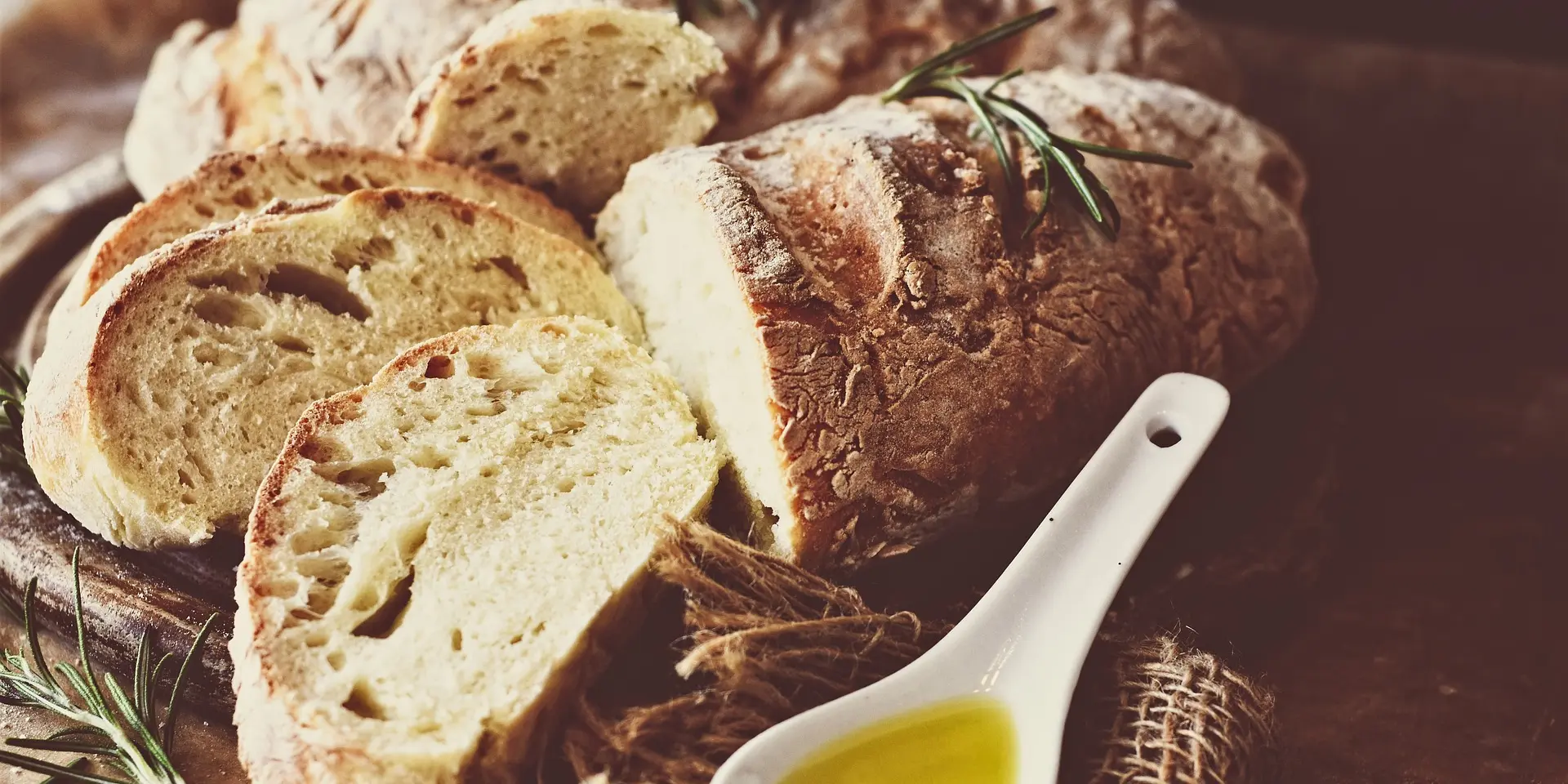Ciabatta bread is made with wheat flour, water, salt, and yeast. It really is what you do with those ingredients makes it a ciabatta.
What is Ciabatta?
Updated:

Image by -Rita-👩🍳 und 📷 mit ❤ from Pixabay
The ciabatta is a relatively young bread recipe dating from 1982. It was supposedly created in Italy by Arnaldo Cavallari, who named the bread ciabatta polesana after the Polesine region of Italy. The Italian Ciabatta was originally produced as an alternative to the French baguette.
The ciabatta recipe consists of wheat flour, water, yeast, salt, and olive oil. What makes ciabatta bread different is that is a chewy bread with a crisp crust, typified by it’s airy dough. The recipe itself was originally licensed only to 11 countries around the world but has since become commonly produced around the globe.
The ciabatta bread is typically used for sandwiches or as a side to soups and savory dishes. You’ve probably seen it served as part of a panini sandwich. In Italy, the ciabatta bread is traditionally consumed dipped in olive oil at any time of day.
In some regions of Italy the Ciabatta is called Filone Bread .
What is the history of ciabatta bread?
You might think that ciabatta originated hundreds of years ago by a sweet Italian grandmother in Italy…but surprisingly, it isn’t an ancient bread recipe, not unless you consider the 1980s to be ancient.
Arnaldo Cavallari created the ciabatta bread in 1982 in Venice, Italy. The Italian baking community found itself concerned over the growing popularity of baguette bread in the country. Naturally, the invasion of French bread threatened their businesses.
With the threat of baguettes over his head, Arnaldo Cavallari got to work creating an Italian alternative. After trial and error, the ciabatta Polesano, named after Cavallari’s homeland in Italy, was born.
Despite its relative lack of cultural significance when compared to other Italian bread, the ciabatta grew in popularity throughout the many regions of Italy, with each boasting their own take on the bread.
Cavallari’s own recipe was soon licensed to bakeries in 11 countries by 1999. It was first introduced in the United Kingdom in 1985 by retail titan Marks and Spencer Group and then to the United States in 1987 to the Orlando Bakery in Cleveland, OH.
The Orlando Bakery quickly developed a frozen alternative to its fresh loaf offerings. Mass production ensued, and the ciabatta spread across the United States and its titans of food production.
Today the bread is well known as a sandwich necessity for the panini and other sandwiches. Bakeries, restaurants, and grocery stores alike boast their own type of ciabatta bread.
Ingredients in Ciabatta
The ingredients of ciabatta bread vary on regional inspiration and country, with the United States ciabatta varying from those of Italian origin, and so on. However, there are key ingredients found in most ciabatta recipes.
- Flour
- Bakers Yeast
- Olive Oil
- Salt
Ciabatta Nutritional Information
Ciabatta bread is not as sweet or fat-heavy as many artisanal bread types.
Ciabatta bread does provide some protein, with an average serving containing roughly 5 grams. It contains about 30 grams of carbohydrates and 278 grams of sodium. However, it provides very little fiber or vitamins.
How to Make Ciabatta
The Ciabatta bread is easily identified by its alveolar holes. These holes are distinctively overlarge in ciabatta and give it its soft texture.
In order to achieve the texture of ciabatta, the yeast, flour, and water are left to ferment for 12-16 hours to create a biga. This biga is a starter for the ciabatta dough but also puts the yeast through a secondary fermentation process which adds flavor to the dough.
The dough should be sticky but not soupy, before the first proofing stage. The ciabatta dough, once mixed and kneaded, goes through three separate proofing processes, the final of which occurs after the dough has been shaped and placed on a greased tray.
Ciabatta bread is typically baked at higher temperatures, between 400 and 500 degrees Fahrenheit to achieve a crisp golden crust. To prevent the dough from losing its moistness, you should mist the dough before baking it.
Ciabatta being an artisan bread, is best enjoyed fresh or wrapped and frozen within a day after baking to preserve freshness.
Ciabatta Recipes
Ciabatta varies depending on the region of the world it comes from. Not every Italian variation is the same, and the variations of the United States are different from their Italian predecessors.
The Italian region of Lombardy, for example, offers a crisp crust and soft texture. However, its cousin in Tuscany has a firmer crust and dense crumb. Roman ciabatta is traditionally seasoned with marjoram or other savory spices.
There are newer variations blossoming. The ciabatta integrale contains wholemeal, where the ciabatta al latte is made with milk instead of olive oil. You can add garlic or tomato to the loaves for a savory dish. Ciabatta is typically served and dipped in olive oil for a healthy snack.
Ciabatta FAQ's
The ciabatta was invented in 1982 by Arnaldo Cavallari, a baker from Adria, Italy.
Ciabatta is a type of Italian bread that is made from wheat flour, water, salt, and yeast. The dough is left to ferment for 12-16 hours to create a biga, which is a starter for the ciabatta dough but also puts the yeast through a secondary fermentation process which adds flavor to the dough.
The ciabatta bread is easily identified by its alveolar holes. These holes are distinctively overlarge in ciabatta and give it its soft texture. In order to achieve the texture of ciabatta, the yeast, flour, and water are left to ferment for 12-16 hours to create a biga. This biga is a starter for the ciabatta dough but also puts the yeast through a secondary fermentation process which adds flavor to the dough. The dough should be sticky but not soupy, before the first proofing stage. The ciabatta dough, once mixed and kneaded, goes through three separate proofing processes, the final of which occurs after the dough has been shaped and placed on a greased tray. Ciabatta bread is typically baked at higher temperatures, between 400 and 500 degrees Fahrenheit to achieve a crisp golden crust. To prevent the dough from losing its moistness, you should mist the dough before baking it.
Ciabatta bread is an Italian bread that is made with wheat flour, water, salt, and yeast. The dough is usually very wet and sticky, which gives the bread its characteristic light and airy texture.
Ciabatta bread originated in Italy, specifically in the Tuscany region. It is thought to have first been made in the early 1980s.
There are many different recipes for ciabatta bread, but the traditional method involves mixing wheat flour, water, salt, and yeast together to form a very wet and sticky dough. This dough is then left to rise for several hours before being shaped into loafs and baked.
The most common ingredients in ciabatta bread are wheat flour, water, salt, and yeast. However, some recipes may also include olive oil, honey, or other additions.
Ciabatta bread is best stored at room temperature, in a bread box or covered with a towel. It can also be frozen for up to 3 months.
Ciabatta bread will last for 3-4 days when stored properly at room temperature.
Yes, ciabatta bread can be frozen for up to 3 months.
Ciabatta bread can be reheated in the oven or microwave. To reheat in the oven, wrap the bread in foil and bake at 350 degrees Fahrenheit for about 10 minutes. To reheat in the microwave, wrap the bread in a damp paper towel and heat on high for 30-45 seconds.
There are many ways to enjoy ciabatta bread. It is often eaten as is, or sliced and used for sandwiches. It can also be toasted and served with butter or olive oil.
One slice of ciabatta bread (28 grams) contains about 70 calories.
Yes, ciabatta bread can be part of a healthy diet. It is a good source of carbohydrates and protein, and it is low in fat and sugar. However, like all foods, it should be consumed in moderation.
Ciabatta bread is a good source of carbohydrates and protein. It also contains small amounts of fat, fiber, and vitamins and minerals.
Ciabatta bread can provide numerous health benefits due to its nutrient content. It can help you meet your daily carbohydrate needs, and it is a good source of protein. Ciabatta bread is also low in fat and sugar, and it provides a variety of vitamins and minerals.
No, there are no known risks associated with eating ciabatta bread. However, as with all foods, it should be consumed in moderation.
There are many recipes that include ciabatta bread, including sandwiches, salads, soups, and appetizers.
Ciabatta bread is widely available in grocery stores and specialty food stores. It can also be ordered online from a variety of retailers.
The price of ciabatta bread varies depending on the brand and where it is purchased. However, it typically costs between $2 and $4 per loaf.
Ciabatta bread has a shelf life of 3-4 days when stored properly at room temperature.
Yes, ciabatta bread can go bad if it is not stored properly. Signs that ciabatta bread has gone bad include mold growth, an off odor, and a stale taste.
Ciabatta bread is fresh if it has a soft texture and a slightly yeasty smell. It should also be free of mold growth and have a pleasant flavor.
